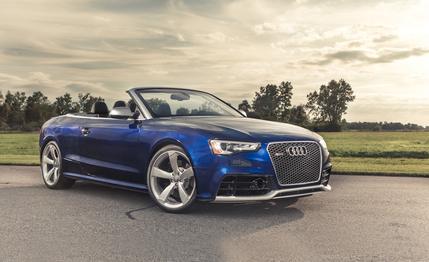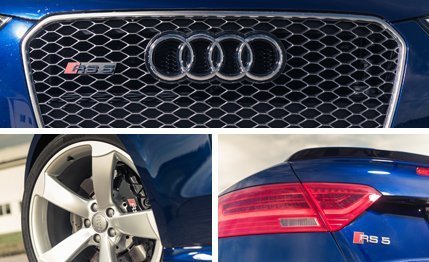
 Instrumented Test
TESTED
Instrumented Test
TESTED
Convertibles are wonderful things, but it takes a certain type of individual to appreciate the Audi RS5 cabriolet’s unique blend of open-air style, speed, and exclusivity. As one of only three ways remaining to enjoy the siren song of a naturally aspirated Audi V-8 (producing 450 horsepower here and in the RS5 coupe and 430 in the R8), it’s certainly not wanting for motivational or mechanical spirit. Mix in Hollywood good looks and the potential for top-down shenanigans, and you have an alluring trifecta of motoring nirvana.
Lots of Grip, A Few Gripes
It’s no secret that cutting the roof off a car, even one as stout as the Audi RS5 coupe, can have demonstrably negative effects on vehicle dynamics. Modern engineering concepts and metallurgy have somewhat mitigated the consequences, but liberating the A-pillars from the rest of the structure without contracting an unwanted case of the shakes is still a tricky business. We love the high cornering limits of the RS5 coupe, so we were pleased when the RS5 cabriolet matched the coupe’s 0.96-g stick on our skidpad, a clue that chassis stiffness hasn’t significantly deteriorated. And while almost any car can be set up to produce maximum grip numbers, it’s the cabriolet’s—and coupe’s, for that matter—ability to transform itself from track star to road car that earns it respect.
Partial credit for this dual-personality goes to Audi’s Drive Select system, which allows drivers to select from Auto, Comfort, Dynamic, or Individual modes. In the latter, drivers can mix and match desired shift characteristics, throttle response, steering, and differential settings to their liking. There’s no electronically adaptive damping going on, however, just a finely honed RS5-specific suspension tune. Meaty 275/30R20 Pirelli P Zero tires belie their massiveness size, rarely tramlining and delivering the same solid, connected, and confidence-inspiring handling exhibited by the coupe over a variety of surfaces.


The variable-rate electronic power steering shared with the coupe offers linear response, and the front wheels follow steering inputs with ESP-like accuracy. Steering effort is weighty, but feedback is virtually nonexistent, with any tiny bits of information that do make it back to the driver arriving vague and encrypted.
A Kick in the RS
All RS5s get a sport rear differential with electronically controlled torque vectoring inserted in the Quattro all-wheel-drive mix. The default torque-split ratio is 40 percent front/60 rear, but it can vary anywhere from 70/30 to 15/85 as conditions dictate. The setup is dialed and it welcomes liberal applications of throttle, almost daring you to see how deep in the pedal you’ll go before the tires throw in the towel. Once the car is pointed straight, however, it simply digs in and takes off.